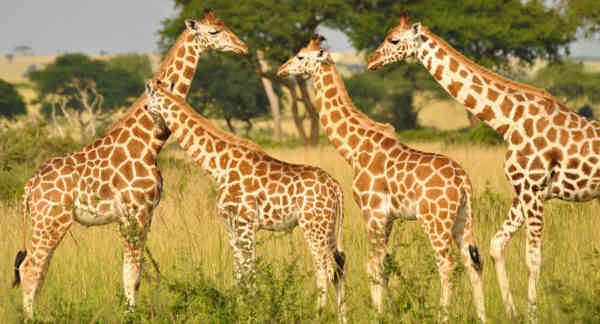Who isn’t surprised by giraffes? These interesting and curious animals are so different from all other inhabitants of our planet that they invariably attract attention, it is worth seeing them. Thanks to the quirks of evolution, they turned out so strange that in the wild they can exist only under certain conditions. However, in the national parks of African countries, giraffes feel quite at ease.
Interesting facts about giraffes
- Of all land inhabitants of the Earth, they are the tallest. They can reach a height of 5.5-6 meters.
- There are only 7 vertebrae in the neck of a giraffe, although it accounts for up to 30-35% of the total growth of this animal.
- An adult giraffe can weigh over a ton.
- The heart of a giraffe weighing up to 10-12 kg pumps about 1 liter of blood per second and creates a pressure in the circulatory system that is three times higher than that in the human body. This is necessary to supply blood to such a highly located brain.
- These amazing creatures can stick their tongue out of their mouths by almost half a meter.
- Up to 20-25% of the total weight of a giraffe falls on a long neck, that is, up to 200-300 kg.
- The pattern of spots on the skin of a giraffe is as individual as human fingerprints or tiger stripes (interesting facts about tigers).
- Vision, and their sense of smell and hearing are very well developed. This helps them detect danger early.
- Giraffes are able to jump over high obstacles. The officially registered record is 1.85 meters.
- In search of food, they constantly roam, living on average in an area of 50-100 square kilometers.
- Since giraffes received together with the vegetation they eat, they are able not to drink water for up to 10-15 days without significant harm to the body.
- Acacia enjoys special honor among giraffes. They are happy to include the leaves of these trees in their menu.
- At short distances, giraffes can reach speeds of up to 55 km/h, overtaking any racehorse (interesting facts about horses).
- To drink from a reservoir, giraffes have to kneel or go chest-deep into the water, otherwise they simply cannot reach it.
- Giraffe fossils show that in ancient times their necks were not so long. However, the long neck helped them get their food more efficiently, and this parameter also plays a role when choosing a male by a female.
- Due to their significant body weight, combined with thin legs and not too large hooves, giraffes cannot move on unsteady surfaces like swamps or deserts.
- They easily notice their relatives at a distance of up to 1000 meters.
- Giraffe blood is very, very thick. This is a kind of natural precaution, because if it were liquid, like in other mammals, a sharp raising or lowering of the head could be fatal for them.
- In Latin, this animal is called «leopard-camel», since ancient Roman scientists decided that giraffes resemble both of them (interesting facts about Ancient Rome).
- Giraffes can also whistle, and roar like predators and moo like cows.
- When born, newborn giraffe cubs fall to the ground from a height of two meters.
- These creatures sleep standing up, not lying on the ground. Moreover, they often sleep, but in snatches of 5-10 minutes, never falling asleep for a long time.
- They devote all their time to searching for food when they are awake, up to eating up to 20 hours a day, or even more.
- Giraffes have an impressive length not only in the neck, but also in the tail, which can grow up to 2 -2.5 meters.
- Most predators do not risk preying on giraffes, as they are capable of inflicting serious injuries on them with their powerful hooves. Lions, however, sometimes attack them (interesting facts about lions).
- Their newborn cubs begin to walk on their own after an hour and a half after birth.
- Giraffes can clean their own ears with their own long tongue.
- In the wild, they live for 20-25 years, but in captivity they can live much longer.
- The extremely dense skin of a giraffe cannot be pierced with a conventional syringe, to inject it, so veterinarians use special injection guns that shoot ampoules with great force.
- Pregnancy in female giraffes lasts about 14 months, one and a half times longer than in humans.
